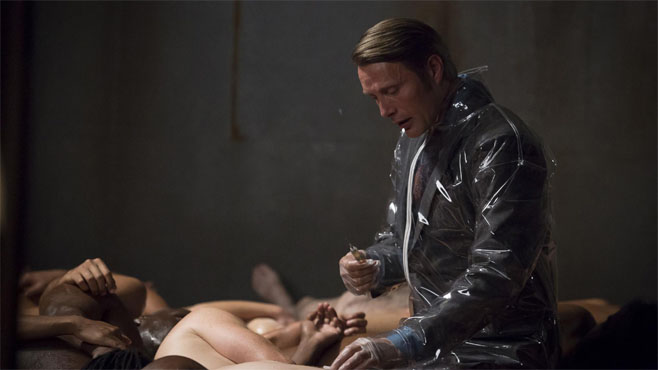TV Review: Hannibal -- "Sakizuki"
Note: This article was originally published at CraveOnline.
The first season of “Hannibal” used the character of Will Graham as a sly commentary on modern audiences who are accustomed to viewing graphic violence on a weekly, if not daily, basis. It was a sharp counter to the idea that fictional violence is harmless, arguing that over time, the simple act of looking could desensitize, manipulate, and distort. Showrunner Bryan Fuller became our own Jack Crawford, pushing us to keep watching, and daring us to recognize the monstrous part of ourselves that enjoys the horror.
That theme is still present in the second season, but now Fuller is expanding his exploration of violence as entertainment, and giving himself a promotion in the process. In the meta-narrative of “Hannibal,” Fuller isn’t just the Jack Crawford to our Will Graham, he’s the God to our troubled, psychopathic selves, confronting us with violence that he himself has created so that we might know him (and ourselves) more fully.
“Sakizuki” is arguably the best episode of the series to date, precisely because it sews these concerns seamlessly into its surface narrative. It’s like a great work of literature (or perhaps a mural of corpses), sprinkling thematic and visual motifs throughout in order to complement the characters’ and viewers’ own journeys. While certain shows succeed because they’re character-driven (“True Detective”) or intricately plot-driven (“Lost”), “Hannibal” is a triumph of theme-driven storytelling, letting its characters develop organically as symbolic archetypes as well as individuals.
The opening scene picks up right where last week left off, with victim Roland Umber managing to tear himself free from the embalmed bodies around him, only to escape the silo right as our mysterious killer returns to finish the job. Director Tim Hunter doesn’t fetishize the violence: it’s a gruesome sight to see a man rip off chunks of his own flesh in order to break free. The direction and editing of this opening is brilliant, taking viewers on a thrilling cat-and-mouse chase through a maze of abandoned cars and a cornfield before subverting our expectations: Umber doesn’t make a daring jump to freedom, like we’ve seen the hero do in hundreds of films. No, he dives straight into a rocky ledge before landing in shallow water. It’s shocking and upsetting — a deliberate contrast to what will occur later.
The next scene finds Will Graham preparing an escape of his own. Though he pretends to be confused and remorseful when he’s with Hannibal and Alana, we soon realize that it’s only a front. He’s steadfast in his certainty that Hannibal has set him up, and now the manipulated has become the manipulator. Whereas the first season followed his gradual brainwashing by Hannibal, the second season seems intent on flipping it the other way. Will hopes to use Hannibal’s obsession to his advantage and gradually get him to make a mistake.
Hannibal seems uncertain of how to handle his doppelganger, and Mikkelsen perfectly captures his conflicting emotions. At the end of the episode, as Will pieces together exactly what happened to Umber’s tormentor, he looks simultaneously uneasy and awe-struck. The intelligent empathy he admires in his “friend” could be the very thing that brings about his downfall, and he knows it. In this battle of wits, who will escape, and who will be splattered on the rocks below?
Nietzsche once said that when you stare into the abyss, the abyss stares back. “Sakizuki” is an episode all about reflections: what we see when we’re confronted with evil, and how we’re drawn to it more than we might like to admit. Fuller, who co-wrote both this episode and the season premiere, seems preoccupied by his own role as a creator — perhaps he’s having an existential crisis of his own. As the man in charge of “Hannibal,” he’s constantly crafting his own mural of fictional bodies, forced to find new ways to present violence as aesthetically beautiful and satisfy a primal impulse. Like Umber’s tormentor, there’s a part of him sewn into every piece of his work—every week, as we watch the narrative unfold, we’re glimpsing a piece of its “God.”
If Fuller is a murderous God, who are we? This episode echoes Hannibal’s theological justification for sadism from the first season: “Are we not created in His image?” The driving theme of “Hannibal” seems to be that there are elements of Will Graham and Hannibal Lecter in each one of us, including Fuller himself, and we must be careful how we satiate the latter. Tim Hunter opens the episode with violence that sickens, but he ends it with a montage that teases and tantalizes, as Hannibal slices and dices a human leg and transforms it into a delicious meal, all set to classical music.
This is the paradox of “Hannibal,” and violent entertainment as a whole: we are horrified by what we watch, yet we watch because we love to be horrified. The only difference between us and Dr. Lecter is that he consumes literally, while we consume figuratively. We watch, Fuller creates, and Hannibal eats, out of a twisted desire for connection with both our fellow man and any god who might have made us this way.
Maybe, once we realize this, it would be best to simply turn away. The last line suggests that Fuller is growing wary of his own creation, and fears that it might perpetuate the cultural sadism that it’s trying to critique: “The conclusion that I’ve drawn is that you are dangerous.” I love “Hannibal,” but perhaps Dr. Du Maurier has the right idea. In a perfect world, we would terminate our relationship with Hannibal the Cannibal by turning off the television and refusing to admire our own reflection.
